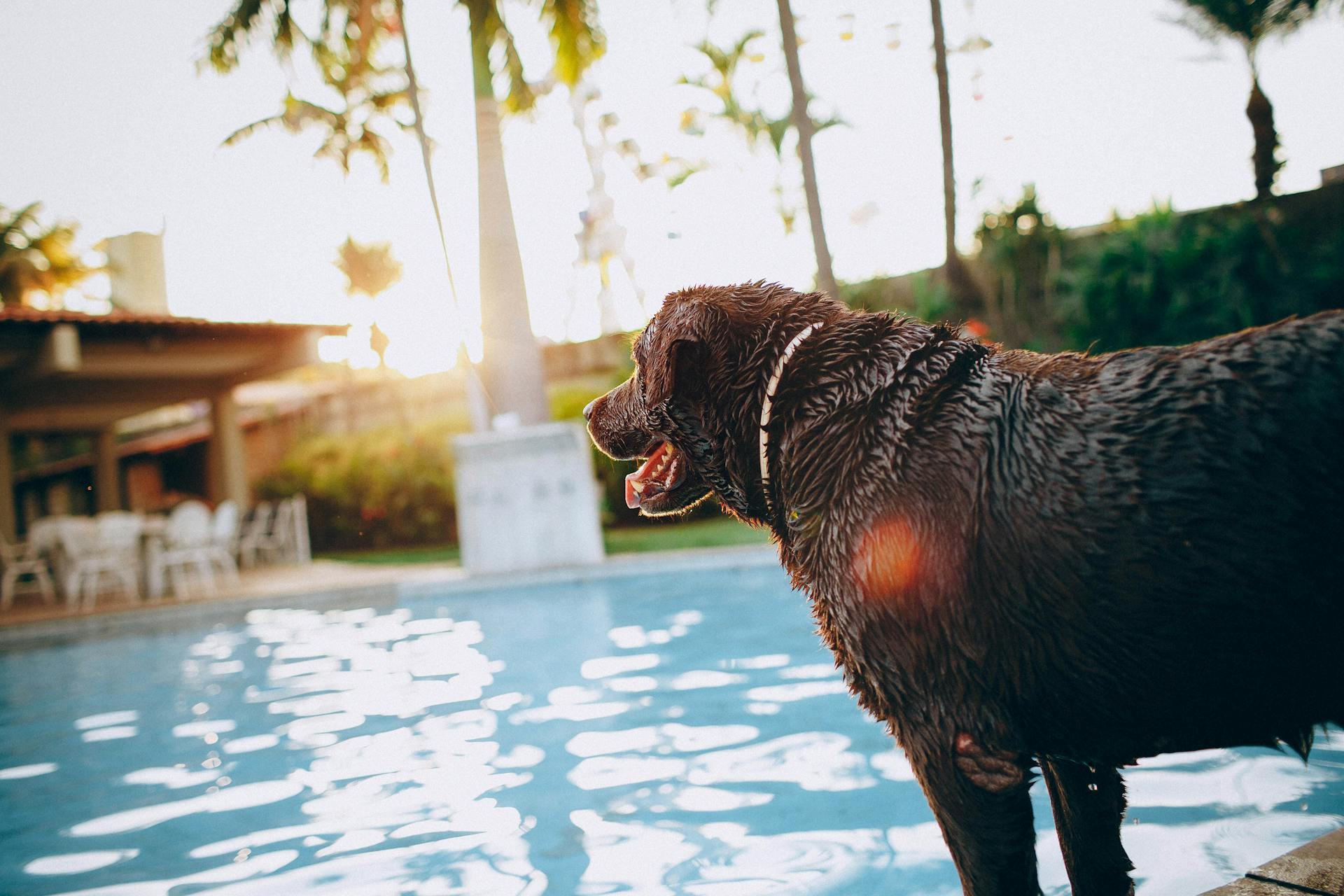
Warning: dogs can get heatstroke too! From signs and symptoms to watch out for, to how to treat heatstroke in dogs, to what causes heatstroke and how to best avoid it – we’re breaking down this medical emergency and giving you the information you need.
What is Heatstroke?
Heatstroke (sometimes called sunstroke or heat stress) describes an elevated body temperature (hyperthermia) which occurs when heat generation exceeds the body’s ability to reduce it. Many people realise there is a risk of overheating in humans, but forget that their dogs are even more sensitive.
Hot tip: Emergency vet visits for animals suffering from heatstroke increase in summer. Prevention is better than cure, so ensure you’re prepared for warm-weather days.
While temperatures of over 30 degrees represent a high risk for heatstroke, cases of heatstroke have occurred in relatively mild conditions, even sunny days with temperatures of 22 degrees Celsius have resulted in heatstroke cases – so best to be vigilant with your pet in warmer months.
Causes of Heatstroke in Dogs
While dogs and humans alike are susceptible to heatstroke, dogs do not have the same capabilities to cool themselves down as humans do. They have fewer sweat glands (only a small amount around their feet and noses) so cannot release heat effectively by sweating. Their bodies are also covered in fur, which is another barrier to keeping them cool. They largely rely on panting to cool themselves down, and this isn’t able to effectively reduce their temperate at a rapid rate if they’re overheating. This is why you need to be mindful of your dog in warm weather – and be prepared to cool them down.
Contributing Factors to Heatstroke in Dogs
When dogs suffer from a case of heatstroke, they have usually been exposed to at least one or a combination of the of the below.
A warm enclosed space (such as a small room or a car) with inadequate ventilation or air flow.
Extended periods exposed to the elements with insufficient shade.
Insufficient drinking water or prolonged periods without access to drinking water.
Excessive exercise (particularly in warm weather).
Hot tip: You may have heard that leaving your dog locked in the car in warm weather is dangerous – but did you know you also need to be careful transporting your dog on hot days as well? Any small space which heats up quickly and doesn’t have sufficient ventilation can cause an episode of heatstroke, so make sure you avoid transporting your dog in the hottest periods of the day or use air conditioning when driving with your dog.
How Do I Know if My Dog Has Heatstroke?
If your dog is suffering from heatstroke, they’ll usually exhibit one or more of the below symptoms.
Hot tip: Don’t rely on your dog to let you know when they’re too hot. Dogs are eager to please and will often keep playing or working through discomfort until their bodies physically cannot go on. It’s up to you to assess how dangerous the situation may be.
Symptoms of Heatstroke in Dogs
Mild/Moderate
- Excessive, heavy panting
- Agitation, restlessness or distress
- Excessive drooling or salivating
- Bright red gums or tongue
- Increased heart rate
- Vomiting
- Diarrhoea
Moderate/Severe
- Lethargy
- Disorientation, confusion, or delirium
- Weakness, dizziness, or staggering
- Muscle tremors
- Collapse
- Seizures
Hot tip: Don’t wait for mild symptoms to develop into severe ones. Cool your dog down immediately and take them to the vet. Heatstroke can lead to multiple organ failure and brain damage, so best to exercise caution.
How do You Treat Heatstroke in Dogs?
Dogs suffering from heatstroke must be taken to vet – though there is fast action you can take at your home and on the way to the vet that can help the problem.

First Aid for Dogs with Heatstroke
- If you suspect your dog is showing symptoms of heatstroke, immediately remove them from the heat as best you can. This might involve moving into the shade if you’re outside, or into a well-ventilated or air-conditioned environment if you’re inside.
- Spray your dog with cool water (it’s important to use cool or even lukewarm water – not ice-cold water as this will make it worse). You can use a spray bottle, a water bottle or even a hose (if you have access to one) to douse your dog in water.
- If you have access to a fan, use this to bring their temperature down further. Otherwise fan the area using whatever you have on hand.
- If your dog isn’t vomiting, try to get them to drink cool water (not ice cold).
- Take your dog to the vet immediately for further treatment. It’s a good idea to bring water-soaked towels to wrap your dog in to keep them cool during the car journey.
Hot tip: When spraying your pet with water, do not use ice-cold water as this will cause their small blood vessels to restrict and thus push their temperature up, not down.
Once you get your dog to the vet, they’ll assess the individual case by checking your dog’s body temperature and vital signs and will provide emergency care based on your dog’s symptoms. This may include putting your dog on IV fluids, giving your dog a cooling enema, medication, or supplemental oxygen, and taking blood tests to check organ function.
How do you Prevent Heatstroke in Dogs?
When it comes to medical emergencies, prevention is always better than cure. There are known factors which will increase the chances of an episode of heatstroke, so be aware of them and always have cooling products to hand in warmer months.
Top Tips to Avoid Heatstroke in Dogs
- Don’t leave your dog locked in the car – even on mild days, with no air flow the internal temperate can rapidly climb to unbearable levels.
- Make sure you always have fresh water available for you dog – especially if you’ve ventured to the beach where saltwater quickly dehydrates them. For working dogs, keep portable water bowls and bottles on hand and take regular breaks on hot days.
- Keep a spray bottle to hand and frequently spray your dog with a water mist throughout play sessions.
- Be mindful when exercising your dog in hot weather and avoid strenuous playtime or workouts when temperatures climb above 30 degrees.
- Avoid muzzling your dog in hot weather.
- If you keep your dog outdoors, make sure they have access to shade.
- Do not tie up or confine your dog in areas without airflow and ensure they’re not resting on a hot surface like concrete of asphalt.
- Keep your dog cool with summer appropriate cooling toys like paddle pools, sprinklers and frozen treat dispensing toys.
- Use cooling collars and bandanas to keep their temperature stable.
- If you need to leave your dog alone for longer periods on hot days have a friend or neighbour check in on them.
- If you don’t have air conditioning, use fans to improve air circulation – particularly in smaller rooms which lack air flow. You can also use cooling mats.
- Add ice cubes to your dog’s water bowl for a cool summer treat.
Hot tip: On hot summer days, exercise your dogs at dawn or dusk when the temperatures are milder. Never walk your dog on concrete or asphalt when temperatures exceed 29 degrees Celsius.
Dogs at Greater Risk of Heatstroke
When it comes to heatstroke, some dogs are more high risk than others. It’s useful to know if your dog is more susceptible to heatstroke so you can be extra careful if need be.
- Brachycephalic breeds (such as pugs, bulldogs, Pekinese, boxers, bull mastiffs, Boston terriers) can’t release heat as quickly as dogs that aren’t short snouted as they cannot pant as easily. They shouldn’t be exercised for more than 30 minutes at a time on warm days.
- Dogs who have previously had episodes of heatstroke are more likely to get it again than dogs who’ve never suffered from it.
- Elderly dogs and small puppies.
- Dogs with pre-existing illness or ongoing medical conditions.
- Dogs with heat conditions.
- Working dogs, or dogs which are exercised in hot weather.
- Dogs that snore or have pre-existing problems with their airways.
- Overweight dogs.

FAQs for Heatstroke in Dogs
How do you know if your dog has heatstroke?
Dogs suffering from heatstroke will first present mild symptoms (such as excessive panting and restlessness) and these will progress to more severe symptoms (vomiting, staggering) if not treated. If you suspect your dog has heatstroke, check for symptoms and practice heatstroke-appropriate first aid while taking your dog to the emergency vet.
How do you treat heatstroke in dogs?
First aid for heatstroke involves taking measures to quickly cool down your dog, as well as taking them to the vet where they may be put on an IV drip or receive other treatment.
How long does it take for your dog to get heatstroke?
How quickly a dog develops heatstroke depends on the dog and the circumstances they find themselves in – but dogs can develop heatstroke as little as 5-10 minutes after being unable to cool themselves down as quickly as they’re taking on heat which is why it’s important to keep your dog hydrated and cool when they’re exposed to warm weather.
Can a dog survive after heatstroke?
A dog can survive an episode of heatstroke. Imperative to their survival is cooling the dog down immediately and taking them to the vet. Once a dog has had an episode of heatstroke, they’re more likely to get it again so be extra careful in the future.